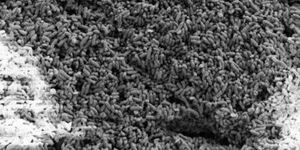Ticks Use Static Electricity to Identify Hosts for Parasitism
A recent study published in Current Biology examines how ticks use static electricity to find hosts to acts as parasites, also known as parasitism, and use this static electricity to carry them to their hosts. Unlike several insect species, ticks are incapable of jumping. Therefore, they much find other means to identify and infect hosts, and this study is a first-of-its-kind to identify how static electricity is used between animals, which holds the potential to help scientists better understand both naturally occurring static electricity and tick behavior, the latter of which could lead to mitigate the frequent spread of diseases by ticks, most notably Lyme disease.
Image of a tick in the wild. (Credit: Sam England)
“We knew that many animals, including humans, can accumulate quite significant electrostatic charges,” said Dr. Sam England, who is a postdoctoral scientist at the Museum für Naturkunde Berlin, but carried out the research while a PhD student at the University of Bristol, and is lead author of the study. “We see this when we get a static shock after bouncing on a trampoline, or when rubbing a balloon on our hair, for example. But this electrostatic charging also happens to animals in nature when they rub against objects in their environment like grass, sand, or other animals.”
For the study, the researchers charged rabbit fur and other relevant materials with static electricity and placed them in close proximity to ticks to see how the tiny insects would react as well as to determine if the ticks were attracted to the charges being emitted. To their amazement, the researchers observed the ticks were lifted into the air by electrostatic charges of distances between several millimeters and centimeters (inches). If ticks were the size of humans, this is analogous of being lifted several flights of stairs. Through further experiments, the team determined the minimum amount of electric field charge required to attract the ticks to a host.
“We have now discovered that ticks can be lifted across air gaps several times larger than themselves by the static electricity that other animals naturally build up,” said Dr. England. “This makes it easier for them to find and attach onto animals that they want to latch onto and feed from.”
For the next steps, the team plans to examine the tick’s ability to sense the electrostatic charge emitted by their expected hosts.
What new discoveries will scientists make about the links between electrostatic charges and animals in the coming years and decades? Only time will tell, and this is why we science!
Sources: Current Biology, BYJU’S, Centers for Disease Control and Prevention, University of Bristol
As always, keep doing science & keep looking up!









